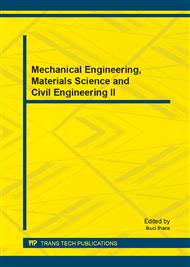p.818
p.823
p.827
p.832
p.838
p.842
p.847
p.857
p.862
Research on Bonding Strength of Steel and Concrete with Different Bonding Interfaces
Abstract:
For the purpose of researching the natural bonding behavior of different interfaces between steel and concrete in SRC structures, four specimens are designed to launch the monotonic push-out loading test. Each specimen is used to consider one case, including the bonding of the external flange, internal flange, web and whole cross-sections with the concrete. Failure process and modes of these specimens were observed during the test. Load-slip curves and ultimate bond strength are obtained and the bonding strength between different interfaces of steel and concrete was analyzed. The results show that the bonding strengths of different interfaces in SRC members are not equal. The minimum bonding strength occurs in web, the bonding strength of external flange is higher, and the maximum bonding strength occurs in internal flange, the ratio of the strength is 1:1.39:1.59.
Info:
Periodical:
Pages:
838-841
Citation:
Online since:
December 2013
Authors:
Price:
Сopyright:
© 2014 Trans Tech Publications Ltd. All Rights Reserved
Share:
Citation:


